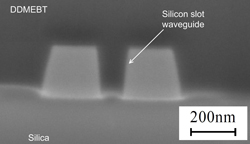
| Home | About Us | Contribute | Bookstore | Advertising | Subscribe for Free NOW! |
| News Archive | Features | Events | Recruitment | Directory |
| FREE subscription |
| Subscribe for free to receive each issue of Semiconductor Today magazine and weekly news brief. |
News
15 April 2009
First all-optical silicon-based signal processing for transmission above 100Gb/s
A collaboration between the University of Karlsruhe, Germany, IMEC in Leuven, Belgium, Lehigh University in the USA, and ETH Zürich in Switzerland has resulted in the first experimental proof of all-optical ultra-fast communication signal processing with silicon-based devices for transmission speeds above 100Gb/s (C. Koos et al, Nature Photonics, April 2009, vol 3, issue 4, p216). The achievement is claimed as a key step towards the development of complex silicon-based photonic integrated circuits (PICs).
 Picture:
Scanning electron microscope image of the cross-section of the vapor-deposited organic film covering the silicon waveguide, which is patterned on a silicon-on-insulator substrate.
Picture:
Scanning electron microscope image of the cross-section of the vapor-deposited organic film covering the silicon waveguide, which is patterned on a silicon-on-insulator substrate.
All-optical signal processing is of particular interest for telecoms applications, where speed, power and cost are crucial. A key element is an optical waveguide with highly nonlinear and ultra-fast performance. Researchers from the University of Karlsruhe, IMEC (and its associated laboratory INTEC at Ghent University), Lehigh University, and ETH Zürich fabricated an optical waveguide structure by combining deep-ultraviolet lithography, standard CMOS processing and organic molecular beam deposition. This 'silicon-organic hybrid' (SOH) approach enables the fabrication of waveguides that pave the way towards all-optical processing.
A 4mm long SOH waveguide with a record nonlinearity coefficient of about 105(Wkm)-1 in the 1.55µm telecom window proved the capability of the SOH concept. Record values predicted by theory have hence been confirmed experimentally for the first time. Based on these waveguides, all-optical demultiplexing of a 170.8Gb/s telecom signal to 42.7Gb/s was performed using four-wave mixing. This is claimed to be the fastest silicon photonic optical signal processing demonstrated to date. This experiment hence proved the viability of the SOH waveguides for all-optical processing of broadband telecom signals.
With the SOH approach, some inherent limitations of silicon could be overcome, say the researchers. Silicon-based technology, in particular silicon-on-insulator (SOI) technology, has already proven very successful for the fabrication of various passive linear optical devices such as filters. The development of ultra-fast active Si-based functionalities, such as all-optical switching, remained challenging due to the slow dynamics caused by unwanted non-linear effects in silicon. So far, the data rate achieved by using bare silicon waveguides was limited to only 40Gb/s.
The SOH approach overcomes this intrinsic limitation - thus enabling data rates above 100Gb/s - by combining the best of two worlds: mature CMOS processing is used to fabricate the waveguide, and organic molecular beam deposition is used to cover it with organic molecules.
These molecules efficiently transfer all-optical interaction without introducing significant absorption. The ability of the organic material to homogeneously fill the slot between the waveguides is a key feature of the deposition process.
The silicon circuits were designed by researchers at the University of Karlsruhe in a fabless way, and were fabricated through the ePIXfab service on IMEC's 200mm silicon photonics platform. ePIXfab is a European-funded initiative coordinated by IMEC to
allow cost-effective fabless prototyping in wafer-scale silicon photonics technology for R&D. The service runs multi-project wafer shuttles in which designs from users worldwide share mask and processing costs.
![]() Search: IMEC Lehigh University ETH Silicon PICs
Search: IMEC Lehigh University ETH Silicon PICs
Visit: www.nature.com
